BUICK SKYLARK 1993 Manual Online
Manufacturer: BUICK, Model Year: 1993, Model line: SKYLARK, Model: BUICK SKYLARK 1993Pages: 306, PDF Size: 15.84 MB
Page 81 of 306
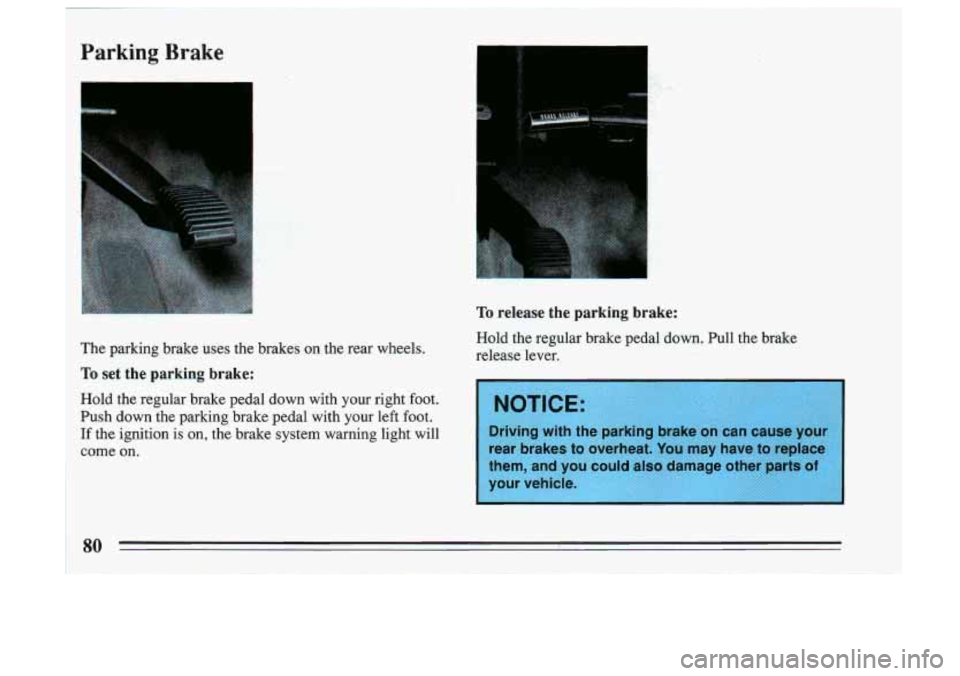
The parking brake uses the brakes on the rear wheels.
1
To release the parking brake:
Hold the regular brake pedal down. Pull the brake
release lever.
80
Page 82 of 306
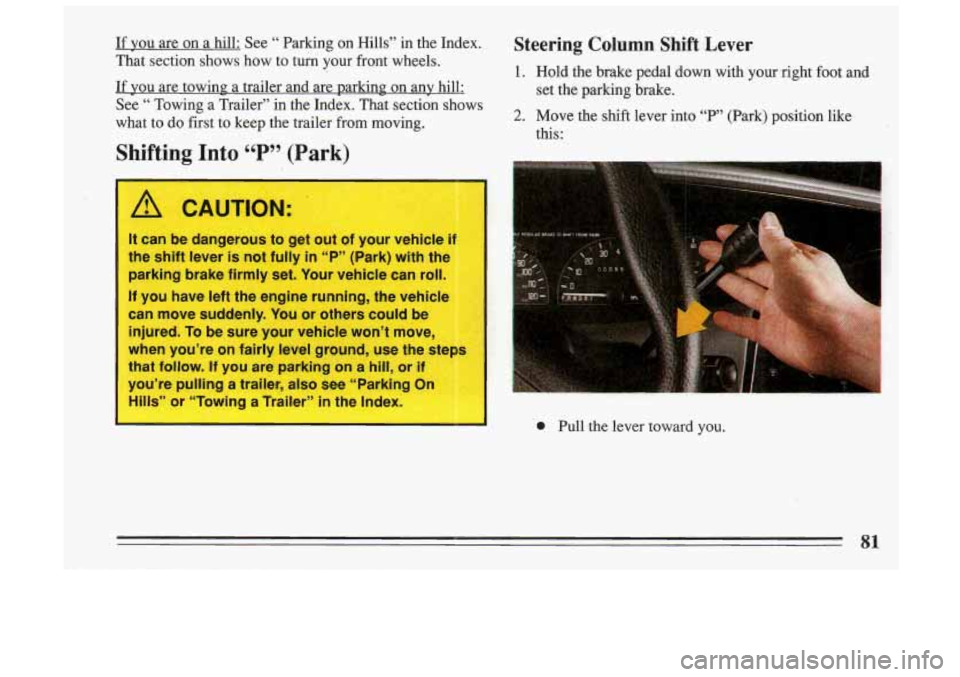
If YOU are on a hill: See “ Parking on Hills” in the Index.
That section shows how to tuk your front wheels.
If you are towing a trailer and are parking on any hill:
See
“ Towing a Trailer” in the Index. That section shows
what to do first to keep the trailer from moving.
Shifting Into 44 P 99 (Park)
I I
A CAUTION:
It can be dangerous to get out of your vehicle if
the shift lever is not fully in “PYy (Park) with the
parking brake firmly set. Your vehicle can roll.
If you have left the engine running, the vehicle
can move suddenly. You or others could be
injured. To be sure your vehicle won’t move,
when you’re on fairly level ground, use the steps
that follow.
If you are parking on a hill, or if
you’re pulling a trailer, also see “Parking On
Hills” or “Towing a Trailer”
in the Index.
Steering Column Shift Lever
1. Hold the brake pedal down with your right fuot and
2. Move the shift lever into “F”’ (Park) position like
set
the parking brake.
this:
0 Pull the lever toward you.
81
Page 83 of 306
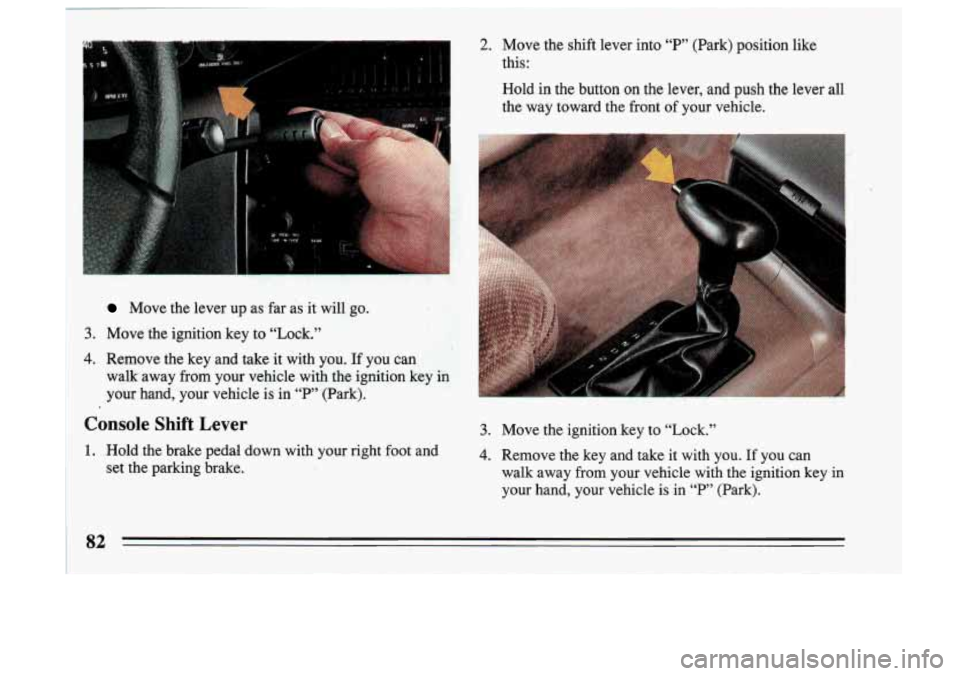
2. Move the shift lever into “P” (Park) position like
this:
Move the lever up as far is it will go.
3. Move the ignition key to “Lock.”
4. Remove the key and take it with you. If you can
walk away
from your vehicle with the ignition key-in
your hand, your vehicle is-in
‘‘P13 (Park).
Console Shift Lever
1. Hold the brake ped4 down with your right foot and
set the parking brake.
Hold in the button on the lever, and push the lever all
the way toward the front of your vehicle.
3. Move the ignition key to “Lock.”
4. Remove the key and take it with you. If you can
walk away from your vehicle with the ignition key in
your hand, your vehicle is in
“P” (Park).
82
Page 84 of 306
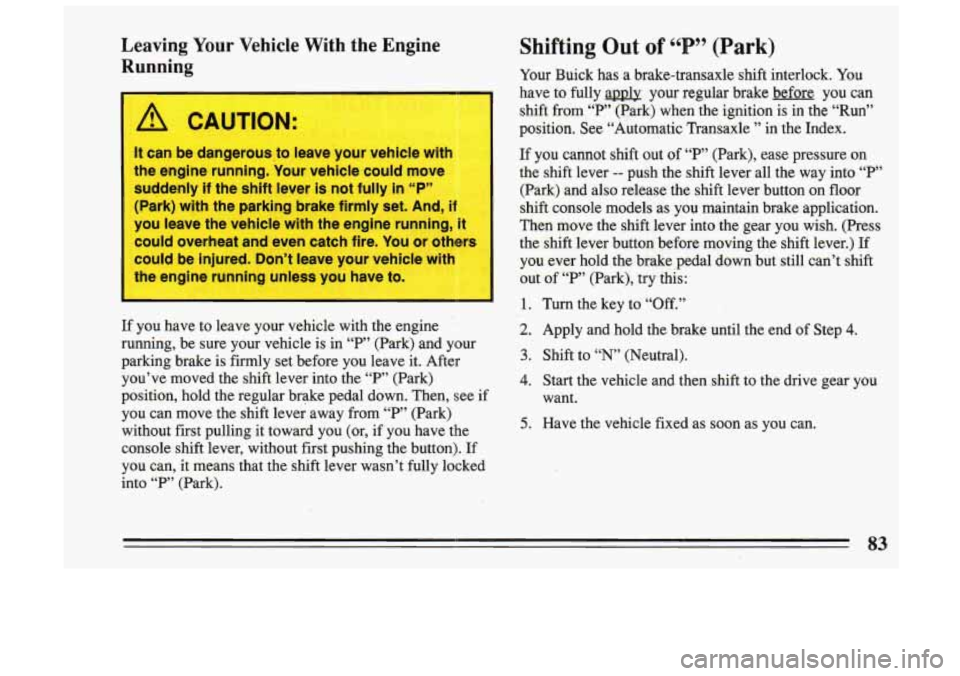
Leaving Your Vehicle With the Engine
Running
CAUTION:
It can be dangerous,to leave your vehicle with
the engine running. Your vehicle could move
suddenly
if the shift lever is not fully in “P”
(Park) with the parking brake firmly set. And,
il
you leave the vehicle with the engine running, it
could overheat and even catch fire. You or others
I
could be injured. Don’t leave your vehic ’ wi
the engine running unless you have to.
I
If you have to leave your vehicle with the engine
running, be sure your vehicle is in
“P” (Park) and your
parking brake is firmly set before you leave it. After
you’ve moved the shift lever into the
“P” (Park)
position, hold the regular brake pedal down. Then, see if
you can move the shift lever away from “P” (Park)
without first pulling it toward you (or, if you have the
console shift lever, without first pushing the button). If
you can, it means that the shift lever wasn’t fully locked
into
“P” (Park).
Shifting Out of P (Park) 66 99
Your Buick has a brake-transaxle shift interlock. You
have to fully applv your regular brake before
you can
shift
from “P” (Park) when the ignition is in the “Run”
position. See “Automatic Transaxle ” in the Index.
If you cannot shift out of “P” (Park), ease pressure on
the shift lever -- push the shift lever all^ the way into “P”
(Park) and also release the shift lever button on floor
shift console models as you maintain brake application.
Then move the shift lever into the gear you wish. (Press
the shift lever button before moving the
shift lever.) If
you ever hold the brake pedal down but still can’t shift
out of “P” (Park), try this:
1. Turn the key to “Off.”
2. Apply and hold the brake until the end of Step 4.
3. Shift to “N’ (Neutral).
4. Start the vehicle and then shift to the drive gear you
5. Have the vehicle fixed as soon as you can. want.
Page 85 of 306
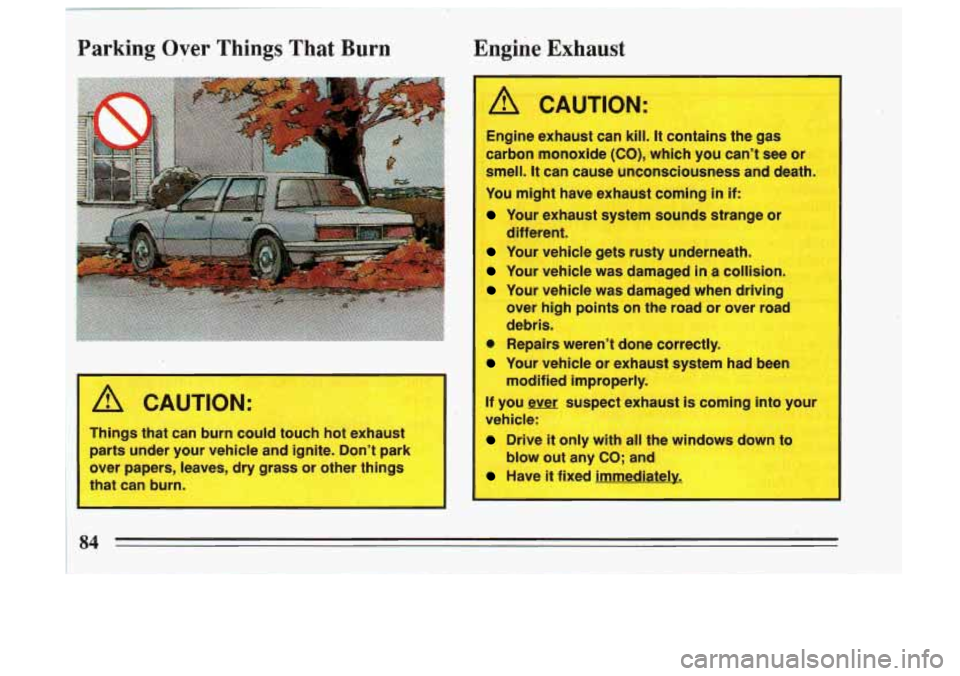
Parking Over Things That Burn
A CAUTION:
Things that can burn could touch hot exhaust
rrts under your vehicle and ignite. Don’t park
over papers, leaves, dry grass or other things
3t can burn.
/1 CAUTION:
Engine exhaust can kill. It contains the gas
carbon monoxide
(CO), which you can’t see or
smell.
It can cause unconsciousness and death.
You might have exhaust coming
in if:
Your exhaust system sounds strange or
Your vehicle gets rusty underneath.
Your vehicle was damaged in a collision.
Your vehicle was damaged when driving
over hinh Doints on the road or over road
different.
debris.
0 Repairs weren’t done
correctly.
I Your vehicle or exha tern had been
modified improperly.
If you ever suspect exhaust is coming into your
I vehicle:
Drive it only with all the windows down to
blow out any
CO; and
Have it fixed immediately.
I
Page 86 of 306
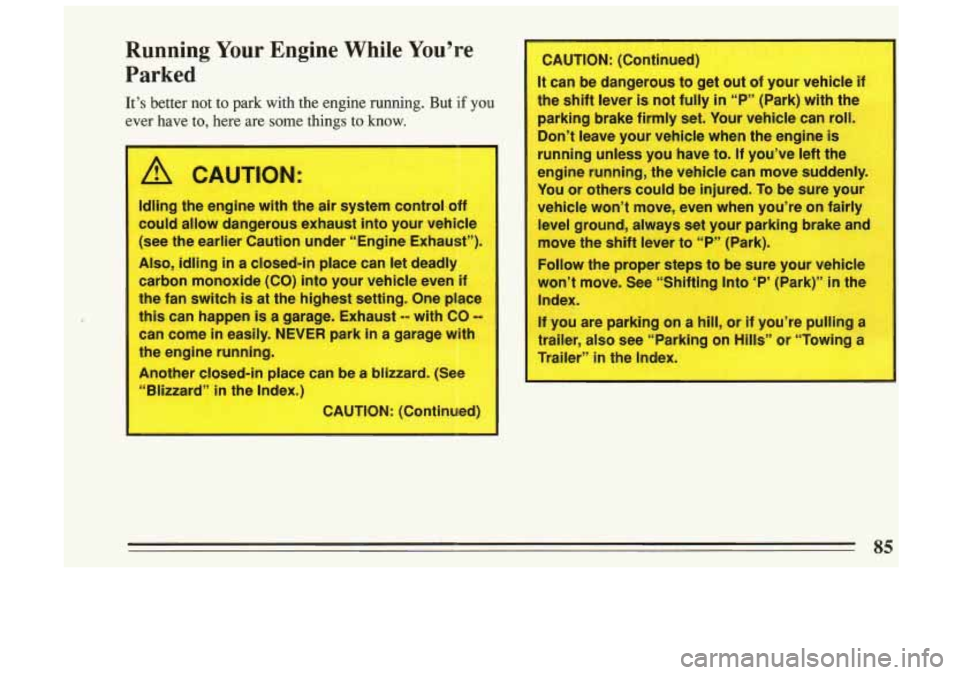
P
-Running Your Engine While You’re
‘Parked
It’s better n.ot to park with the engine running. But if YOU
ever have to, here are~same things to how.
Idling the engine with tfie air 31 em control off
8could al~low dangerous exhaust into jour vehilcle
(see the earlier Cawtionunder “‘Engine IExhaust”:
Also, idling In a Closed-in> place can let‘ ‘dead.,
‘carbon monoxide
(CO) into yo~ur ve,hicle ewn if
t’he fan switch
is at the highest setting. One placl
this can happen is agarage. Exhaust -- with CO
can came in easily. #NEVER park in a garage with
the engine running.
Another clq3ed8-in;
place can be a blizzard. l(See
in the Index.)
nued:
It can ‘be dangerous ta get ‘olut lof ,your vehicle if
‘the shift lever is not fully
in T’ (Park) witlh trhe
parking brake flirmly set. Your vehicle
can roll.
Dm’t leave yaur vehic;le when the engine
is
running unless you have to. If you’ve lefi the
enlgine running, the vehicle can
move suddenly.
You
or others cou!ld be injured. To be sure yow’r
vehicle wonlpt move, even when
you’re on fair ~
level gramd, always set your parking brake and’
move
the shift lever to “P” (Park).
Follow the prope!r steps
to be sure your vehicle
wm’t move. See “S’hifting
Into ‘PB (Park)”’ in the
Inde?.
If
you are parking on a hill, or if you’lre pulling a
trailer,
atso see “Parking OM Hills”’ or “Towing, a
‘Trailer”
in th’e Index.
85
Page 87 of 306
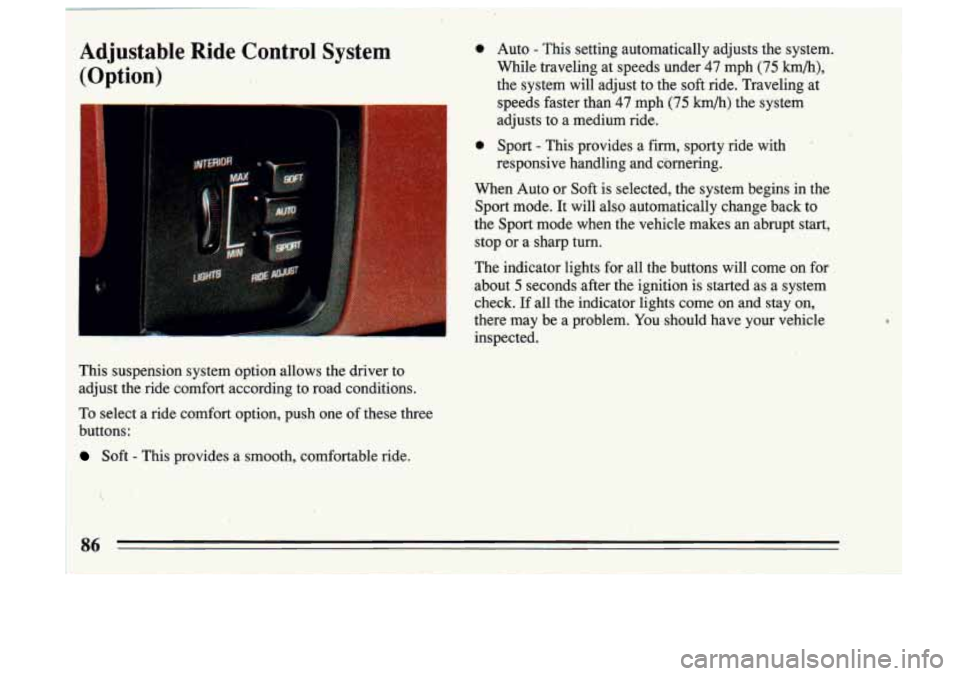
Adjustable Ride Control System
(Option)
adjusts to a medium ride.
0 Sport - This provides a firm, sporty ride with
This suspension system option allows the driver to
adjust the ride comfort according to road conditions.
To select a ride comfort option, push one of these three
1 buttons:
i Soft - This provides a smooth, comfortable ride.
0 Auto - This setting automatically adjusts the system.
While traveling at speeds under
47 mph (75 km/h),
the system will adjust to the soft ride. Traveling at
speeds faster than
47 mph (75 km/h) the system
responsive handling and cQrnering.
When Auto or
Soft is selected, the system begins in the
Sport mode. It will also automatically change back to
the Sport mode when the vehicle _---lkes anabrupt start,
stop or a sharp turn.
The indicator lights for all the buttons will come on for about
5 seconds after the ignition is started as a system
check.
If all the indicator lights come on and stay on,
there may be a problem.
You should have your vehicle
inspected.
Page 88 of 306
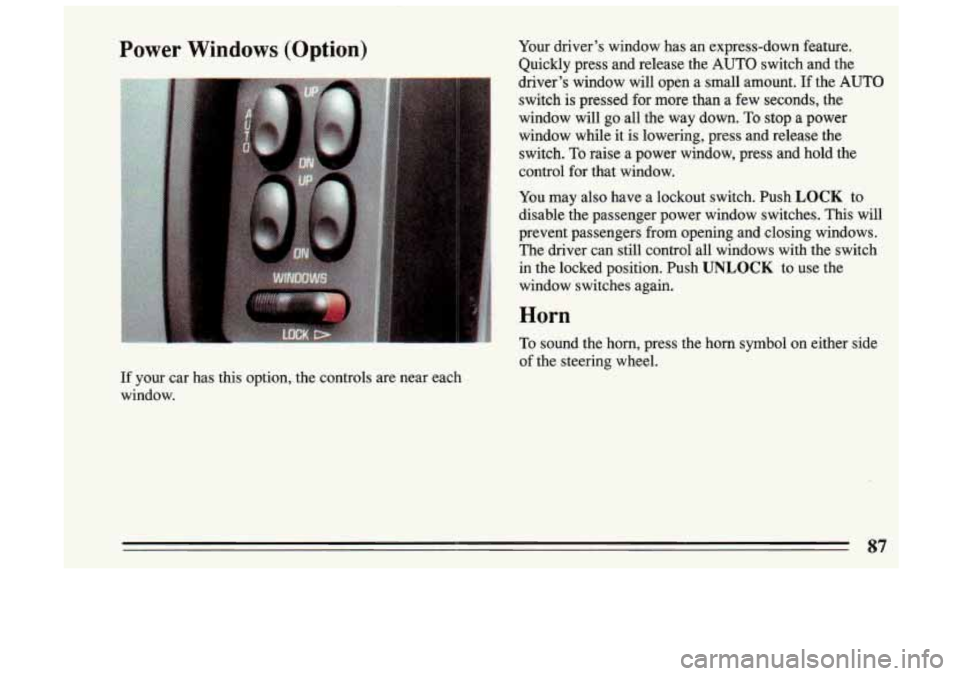
Power Windows (Option) Your driver's window has an express-down feature.
Quickly press and release the AUTO switch and the
driver's window will open a small amount.
If the AUTO
switch is pressed for more than
a few seconds, the
window will go all the way down. To stop a power
window while it is lowering, press and release the
switch. To raise a power window, press and hold the
control for that window.
You may
also have a lockout switch. Push LOCK to
disable the passenger power window switches. This will
prevent passengers from opening and closing windows.
i The driver can still control all windows with the switch
' in the locked position. Push UNLOCK to use the
1 window switches again.
I
1 Horn
' To sound the horn, press the horn symbol on either side
of the steering wheel.
If your car has this option, the controls are near each
window.
87
Page 89 of 306
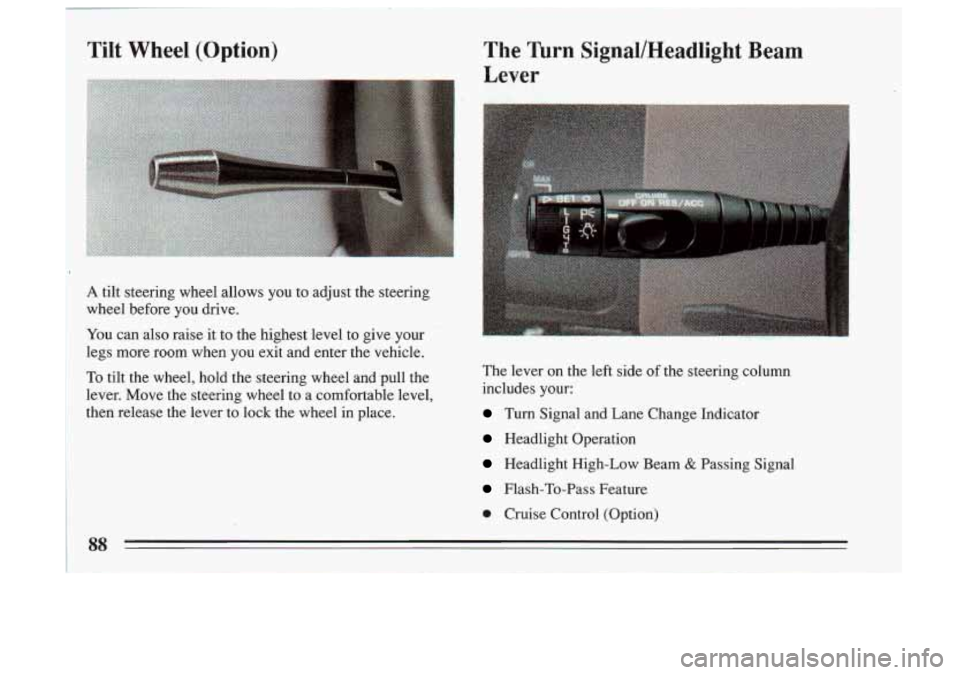
!
Tilt WheeI (Option)
A tilt steering wheel allows you to adjust the steering
wheel before you drive.
You can also raise it ,to the highest level to give your
legs more room when you exit and enter the vehicle.
To tilt the wheel, hold the steering wheel and pull the
lever. Move the steering wheel to a comfortable level,
then release the lever to lock the wheel in place. The lever on the left side
of the
steering column
includes your:
Turn Signal and Lane Change Indicator
Headlight Operation
Headlight High-Low Beam & Passing Signal
Flash-To-Pass Feature
0 Cruise Control (Option)
88
Page 90 of 306
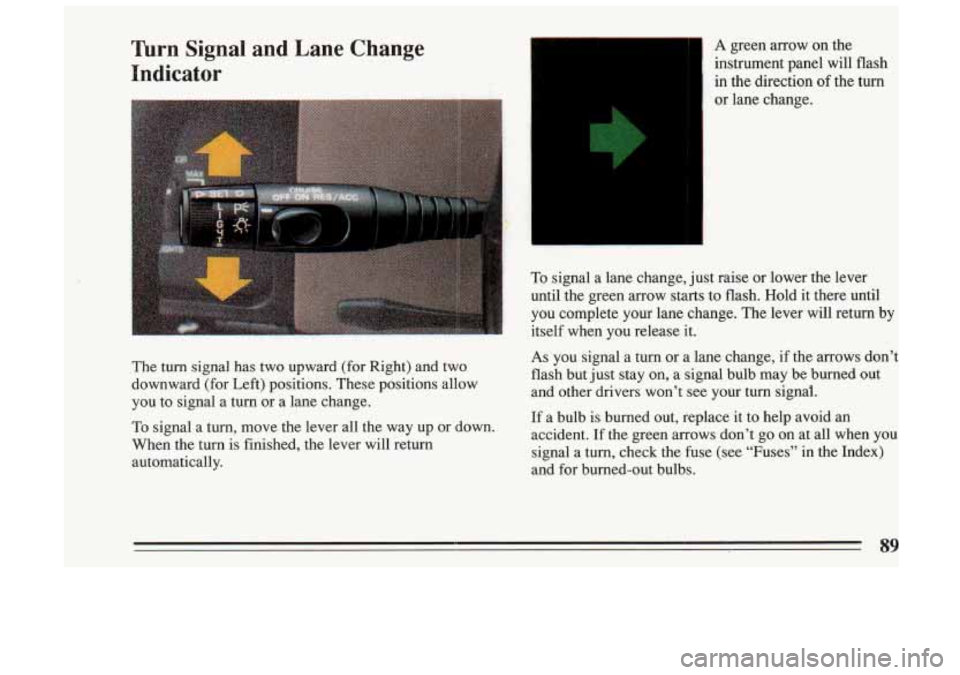
Turn Signal and Lane Change
Indicator
The turn signal has two upward (for Right) and two
downward (for Left) positions. These positions allow
you to signal a turn or a lane change.
To signal a turn, move the lever all the way up or down.
When the turn is finished, the lever will return
automatically.
i”’
A green arrow on the
instrument panel will flash
in the direction of the turn
or lane change.
To signal a lane change, just raise or lower the lever
until the green arrow starts to flash. Hold it there until
you complete your lane change. The lever will return by
itself when you release it.
As you signal a turn or a lane change, if the arrows don’t
flash but just stay on, a signal bulb may be burned out
and other drivers won’t see your turn signal
If a bulb is burned out, replace it to help avoid an
accident. If the green arrows don’t go on at all when you
signal a turn, check the fuse (see “Fuses” in the Index)
and for burned-out bulbs.
89